ITALY
Economy

Economy
Cities in ITALY
| Bologna | Florence | Milan |
| Naples | Rome | Trieste |
| Venice | Verona |
Popular destinations ITALY
| Campania | Lombardy | Sardinia |
| Sicily | Tuscany | Umbria |
| Veneto |
Economy
General
After World War II, Italy turned into a modern industrial nation. Between 1950 and 1980, the gross national product (GNP) per capita grew by 200%. After 1980 it all went a bit less and growth fell to an average of 1.3% per year. In recent years, Italy has faced a severe economic crisis and the economy shrinks by -2.4% in 2012 and -1.8% in 2013. After this, the economy will recover somewhat, but will lag behind at European level. The growth in 2017 was 1.5%. As a result, the unemployment rate rose to 11.3% in 2017 and a public debt grew.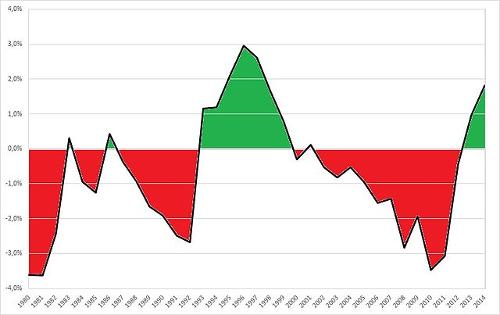 Italian current account balance, % of GDP (1950-2014)Photo: T,C&S at Italian Wikipedia CC 3.0 Unported no changes made
Italian current account balance, % of GDP (1950-2014)Photo: T,C&S at Italian Wikipedia CC 3.0 Unported no changes made
A striking feature of the Italian economy is the large difference in prosperity and development between the industrialized north and the still predominantly agricultural south.
The causes must be sought in differences in historical development, geographic location and physical environment. Since 1950, with the establishment of a development fund for the south (Cassa per il Mezzogiorno), the government has been trying to close the existing wealth gap. Initially, most of the enormous investment money was used to modernize the agricultural sector and improve infrastructure. However, when it turned out that the modernization of the agricultural sector did not increase employment, but rather reduced employment, the emphasis shifted to investments for rapid industrialization. Although the income level in the south has risen sharply as a result, the gap with the north is still far from being eliminated.
The turbulent economic growth after 1945 is therefore almost entirely due to the industrial expansion that took place in the north. The industrial complexes created in the south are not very labor-intensive, static units, which can often only be maintained with public support.
The major role of the government was characteristic of the Italian economy. Not only the local supply companies, the railways and the airlines are state-owned companies, but also the oil and natural gas companies, the steel industry, the ship and train building, the machine industry and the blast furnaces were for the most part state-owned. Large-scale privatizations must increase the effectiveness of the business community and reduce the government deficit. In 1997 it was decided to dismantle the state-owned company IRI in 3 years, which would facilitate the sale of various state-owned companies.
The remarkable thing about Italy as a modern industrial state is the fact that 90% of Italian (family) companies have between 11 and 500 employees, so there are a lot of small and medium-sized businesses. On the other hand, 40% of companies with less than 50 employees depend mainly on exports.
Agriculture, livestock, forestry and fishing
Agriculture
Only 3.9% of the population was employed in agriculture in 2017. The share of this sector in GNP was 2.1% in the same year. Many farms are very small: approx. 75% of the farms have an area of less than 5 hectares. Agriculture in central and southern Italy has a mainly traditional character and is the main means of subsistence south of the Arno River. In the wet season maize is grown in the south and viticulture and olive cultivation are also very characteristic of these regions.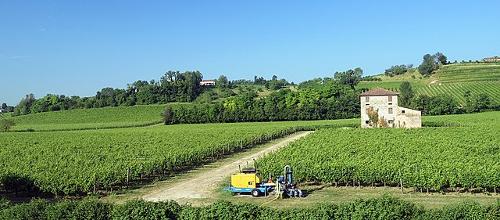 Field near Ogliano, Conegliano in ItalyPhoto: Tiia Monto CC 3.0 Unported no changes made
Field near Ogliano, Conegliano in ItalyPhoto: Tiia Monto CC 3.0 Unported no changes made
The precipitation frequency is important for the type of crops that can be grown. Furthermore, Italy consists of only 20% low plains, so that the steep slopes can actually only be used for forestry or as pasture land. The size of the agricultural businesses varies greatly from region to region. However, small businesses still dominate, but areas in the Alps and Apennines are also home to many large companies. The Po Valley is the most productive agricultural area in Italy. The lowlands of Campania are the best agricultural area in southern Italy due to the volcanic soil.
The main cereals are of course wheat as the raw material for the many pastas, followed by corn and rice. Wheat is mainly grown in central and southern Italy, maize in the plains north of the Po and rice in the Po plain around Milan between the rivers Dora Baltea and Adda.
Other widely cultivated crops are legumes (also for export: Italy is Europe's largest producer of soybeans) throughout Italy, potatoes mainly in central Italy, tobacco in Apulia, hemp around Naples and in the Podelta and cotton in Sicily. The cultivation of fruit and vegetables is spread all over Italy and the flower cultivation is found in Liguria, among other places.
Tree cultures are also typical of the agricultural landscape, with many grapes, olives and citrus fruits.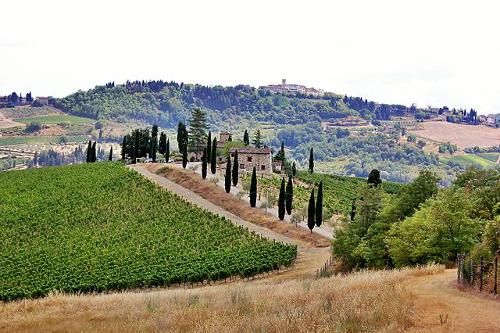 Village in the Chianti Hills, Tuscany, ItalyPhoto: http://www.justraveling.com CC 4.0 International no changes made
Village in the Chianti Hills, Tuscany, ItalyPhoto: http://www.justraveling.com CC 4.0 International no changes made
Viticulture occurs throughout Italy and consists of two thirds of red and one third of white wine. The famous Chianti wine comes from the Tuscany region. Four different grape varieties are used for this wine, which are grown in the Chianti mountains. Olive cultivation takes place mainly in Apulia and Calabria and the olives are mainly processed into olive oil. Oranges and lemons are mainly grown in the southern regions of Sicily, Campania and Calabria. Apples, pears and plums are becoming much more common in the north, e.g. Emilia-Romagna and South Tyrol.
The mulberry trees for silk cultivation are mostly in the Po Valley. The region around Alba, in Piedmont, and the area around Norcia and Spoleto, in Umbria, are the truffle paradises of Italy. Today truffles are traced by dogs instead of pigs.
Livestock farming
Cattle farming is mainly found in Lombardy, Veneto, Piemonte and Emilia-Romagna. Milk production is almost entirely concentrated in Northern Italy. However, milk is mainly imported from Germany
Sheep and goat farming is becoming more common in the islands of Sicily and Sardinia. The pig farms are mainly located in Emilia-Romagna and Lombardy.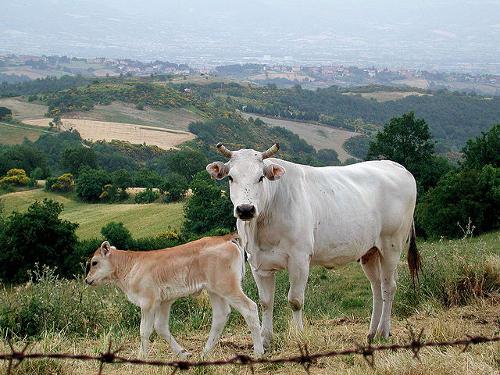 Tuscan Chianina breed, where the Florentine steaks come fromPhoto: Monica from Anghiari (AR), Italy CC 2.0 Generic no changes made
Tuscan Chianina breed, where the Florentine steaks come fromPhoto: Monica from Anghiari (AR), Italy CC 2.0 Generic no changes made
Forestry
About 23% of the Italian land area is covered by forests, which are used for wood and fuel supply. Sixty percent of the Italian forests are located in Northern and Central Italy. Forty percent can be found in southern Italy, Sicily and Sardinia.
For hundreds of years, large-scale deforestation has taken place and reforestation is currently taking place to reduce erosion. Real wood regions are Trentino-Alto Adige and Lombardy.
Fishing
The Italian fishery mainly takes place off the Adriatic coast and the main species fished for are anchovies, sardines, tuna, squid and crustaceans.
Mining and energy supply
Italy is very poor in raw materials. Coal, for example, is almost completely absent and iron ore is found in small quantities. Lead and zinc are mainly found in Sardinia and in the Alps. Italy used to be one of the largest producers of mercury. Marble is exploited at Carrara.
In Italy, about 80% of the energy required is imported from abroad. Natural gas is mainly imported from Algeria and Russia and oil from the Middle East.
One third of the electricity production comes from hydropower plants (mainly in the Alpine region) and the rest comes almost entirely from thermal power plants.
Industry
In 2017, 28.3% of the labor force worked in the industrial sector, which contributed 23.9% to GDP. Italy is the fourth industrial state in Europe after Germany, France and England.
The largest industries are distributed across the country as follows:
Iron and steel industry
Machine industry is mainly found in the north:
Turin: cars (especially Fiat), motorcycles and planes.
Milan: electrical engineering, locomotives, cars, scooters and motorcycles.
Genoa: shipyards.
Other important industrial cities in the north are: Bologna, Vicenza, Ivrea (Olivetti), Brescia, Pavia and Legnano (textile machines).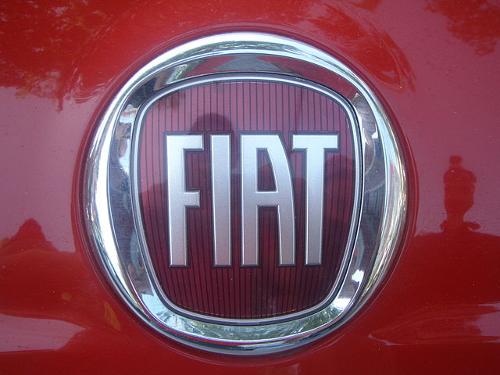 Logo Fiat, ItalyPhoto: SurfAst CC 3.0 Unported no changes made
Logo Fiat, ItalyPhoto: SurfAst CC 3.0 Unported no changes made
Chemical industry
Italy's chemical industry is one of the largest in the world due to the presence of raw materials and ports where imported raw materials such as petroleum, coal and phosphate are processed.
Turin: rubber and plastics (Pirelli tires).
Milan: petrochemicals (Montedison).
Palermo, Crotone, Porto Empedocle: fertilizers because of the livestock farming there.
Textile industry
Northwest Po plain: textile industry.
Como: silk industry that is still the most important in Western Europe.
Varese-Bergamo-Milan, Val Seriana: cotton industry.
Lombardy, Piedmont, Naples, Calabria: rayon yarn and synthetic fibers.
Food, beverages and tobacco industry
The companies in this industry are distributed all over the country.
Southern Italy and Sicily: pasta factories.
Naples and Salerno: food industry related to the presence of vegetable and tomato cultivation (pasta sauces).
Perugia: chocolate.
Milan: panettone, a type of Christmas pastry.
Other industries
Como, Brescia and the south of Piemonte: cement industry due to the presence of lime and marl.
Milan, Como and Pisa: wood processing, furniture manufacture.
Vigevano, Varese province: shoe industry.
Trade
The most important import products are petroleum, raw materials for the metal and textile industry, wood, machinery, cars and food (including meat). The main import partners in 2017 were: Germany (16.3%), France (8.8%), China (7.1%), the Netherlands (5.6%), Spain (5.3%) and Belgium (4 , 5%).
The main exports are textiles, citrus, wine, machinery, cars, computers, plastics and petroleum products.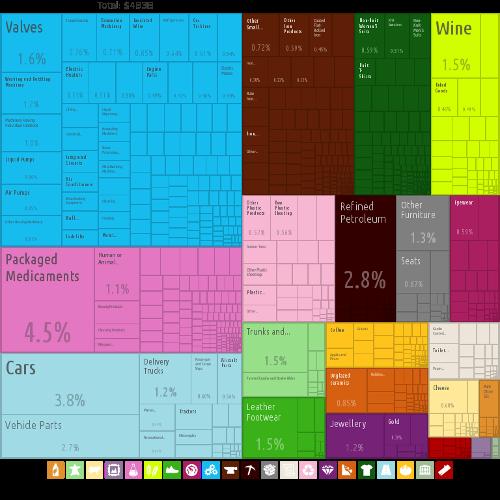 Export products ItalyPhoto: Alexander Simoes, Cesar Hidalgo, et. al. CC 3.0 Unported no changes made
Export products ItalyPhoto: Alexander Simoes, Cesar Hidalgo, et. al. CC 3.0 Unported no changes made
The main export partners in 2017 were: Germany (12.5%), France (10.3%), United States (9%), Spain (5.2%), United Kingdom (4.7%) and Switzerland (4 , 6%).
Traffic
The Alps and to a lesser extent the Apennines are gigantic obstacles to traffic. Despite this, Italy has an excellent network of transport connections. The Italian road network is of reasonable quality. The total length is more than 300,000 km, of which 70,000 km is autostrada. The most famous motorway is the "autostrada del sole", which runs along the west side of the boot and thus forms the main artery for all of Italy.
The railway network covers 20,000 km, of which more than 12,000 km is electrified.
Due to siltation and silting on the one hand and the rocky arched coasts on the other, the coast is not very attractive for shipping, but Italy still has a number of good natural harbors.
Genoa is the main port, followed by Venice, Naples, Savona, Livorno, La Spezia, Taranto and Trieste. Inland shipping is not of big importance.
The largest airports are located in Rome (Fiumicino) and Milan (Linate). The state airline is Alitalia.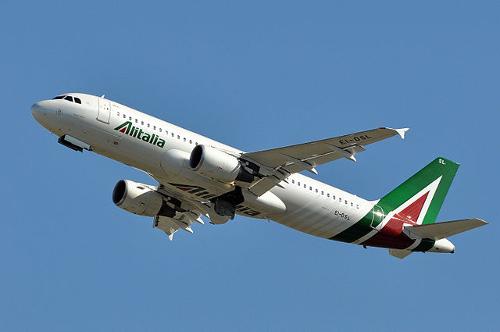 Airbus A320-216 of Alitalia, national airline of ItalyPhoto: ERIC SALARD CC 2.0 Generic no changes made
Airbus A320-216 of Alitalia, national airline of ItalyPhoto: ERIC SALARD CC 2.0 Generic no changes made
Sources
Cassidy, P. / Italy
Raintree Steck-Vaughn Publishers
Europa
Lekturama
Europese Unie : vijftien landendocumentaties
Europees Platform voor het Nederlandse Onderwijs
Jepson, T. / Italië
Van Reemst
The Statesman's Yearbook: the politics, cultures and economies of the world
Macmillan Press
CIA - World Factbook
BBC - Country Profiles
Copyright: Team The World of Info